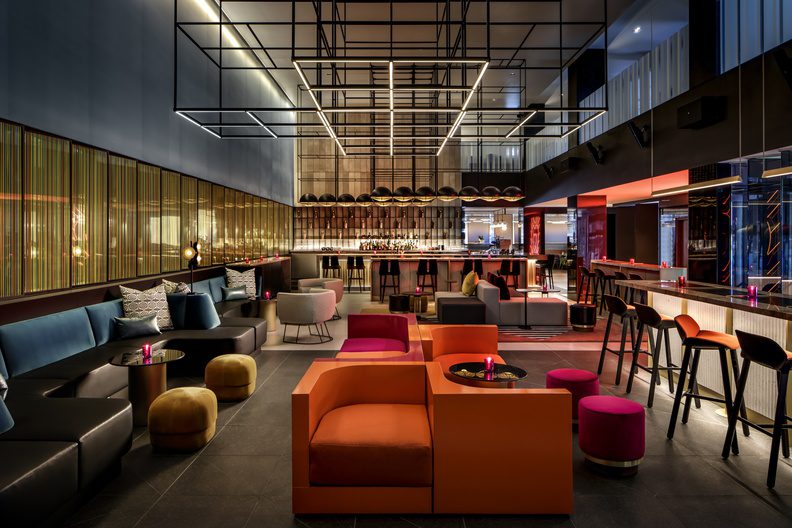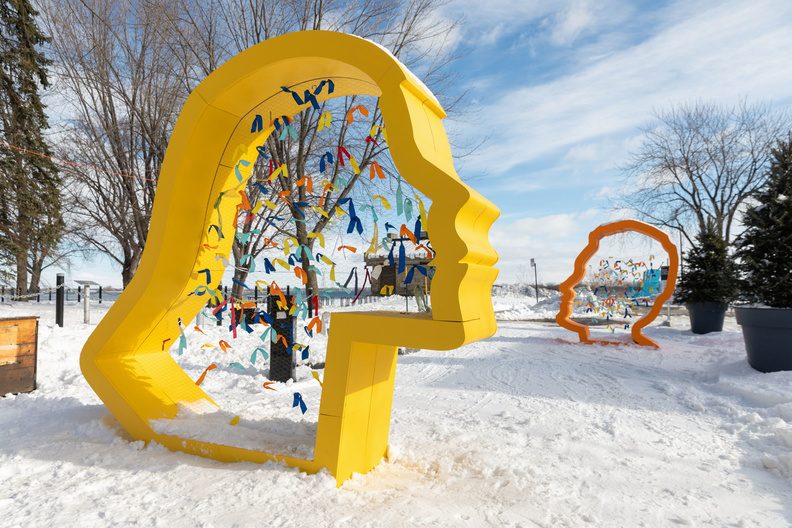Coralie Olson, associée directrice de MASSIVart à Toronto, a récemment eu le plaisir de participer à une table ronde au Interior Design Show (IDS) de Toronto sur le sujet du placemaking – destinations, communautés, connexions, fabrication – dans un monde post-pandémique. Le placemaking nous offre aujourd’hui une occasion unique de reconstruire les relations entre les gens et les lieux, et de faire face à un nouveau monde basé sur l’expérience.
Panélistes
George Foussias, Directeur du design chez Lemay
Louis-Etienne Dubois, Professeur associé à l’Ryerson University
Coralie Olson, Associée directrice chez MASSIVart Toronto
Heela Omarkhail, Vice-présidente, Impact social chez The Daniels Corporation
Moderator
Vedran Dzebic, Coordinateur de la recherche et du développement chez Entro
Au cours de la discussion, les quatre panélistes ont chacun amené un point de vue unique sur le concept de placemaking. Heela Omarkhail l’a défini comme un ensemble d’outils qui améliorent notre expérience dans un espace, en apportant des souvenirs et une connexion à celui-ci. Pour Louis-Etienne Dubois, les lieux sont des espaces que les gens ont rendus significatifs. Coralie Olson, de MASSIVart, a partagé son point de vue : « Les gens sont au centre du placemaking. Le moyen le plus puissant pour se connecter avec les gens est l’art et la culture. »
Omarkhail considère l’espace comme la plateforme ou la toile vierge du placemaking, où le placemaking est l’ensemble des outils ou la boîte à outils. Les outils nécessaires pour un environnement public ou privé, ou un espace intérieur ou extérieur, seront différents et comprendront des aspects tangibles et intangibles. Les aspects tangibles du placemaking incluent le design, la matérialité, les finitions, le mobilier, la signalisation, les œuvres d’art, et plus. Les aspects plus intangibles, comme la musique, ainsi que la programmation et les événements, sont au cœur de la création d’une communauté.
Le placemaking nécessite une certaine intentionnalité. « Construisez-le, soyez intentionnel, ajoutez ces interventions et ces outils et, petit à petit, les gens commenceront à venir et à se connecter avec cet espace. » – Heela Omarkhail

La fonctionnalité des espaces a changé depuis la pandémie. Les développeurs doivent désormais s’interroger sur l’utilisation de grandes tables modulables par exemple, pour accommoder des individus souhaitant avoir des tables séparées et plus petites. Il faut savoir en faire une expérience où ces tables iraient aussi bien ensemble que séparément.
Les espaces extérieurs ont pris de l’importance au cours de la pandémie. Y a-t-il un regain d’intérêt pour les espaces publics extérieurs ?
Afin de créer une expérience, les professionnels sont obligés de penser beaucoup plus largement à ce que signifie l’espace extérieur, au-delà des parcs publics. George Foussias a ajouté que le fait de ne plus avoir accès aux espaces intérieurs pendant le COVID nous a poussés à nous déplacer à l’extérieur comme extension naturelle. De ce fait, nous changeons notre façon de voir l’intérieur, l’extérieur et les aménagements nécessaires pour les deux.
Pour Dubois, l’espace extérieur offre un sentiment de sécurité, la possibilité de respirer de l’air frais après avoir porté des masques pendant si longtemps. En creusant un peu plus, on s’aperçoit que plusieurs raisons qui nous ont attirés vers l’extérieur peuvent facilement être reproduites dans les aménagements intérieurs. Les espaces vides, ainsi que les espaces ouverts ou les îlots présents dans les parcs par exemple, sont des concepts qui peuvent facilement être mis en œuvre à l’intérieur et qui continueront à être prédominants à l’avenir.
“Il y a quelque chose d’intentionnel quand on va quelque part ou quand on arrive à une destination”, Dubois a noté. L’un des éléments les plus importants à prendre en compte par les concepteurs et les planificateurs en matière de création de lieux est cette expérience holistique, sociale, culturelle et centrée sur l’humain. En arrivant à une destination, lorsqu’on y réfléchit ou qu’on éprouve certains sentiments à son égard, on s’y attache, émotionnellement, physiquement et psychologiquement. C’est précisément à ce moment-là que l’espace devient un lieu.
Avec la COVID, les gens vont probablement développer une nouvelle perception du lieu et rechercher des attributs ou des sentiments différents qui n’étaient pas aussi importants auparavant, comme la sécurité ou même la propreté. À l’avenir, il se peut que les personnes soient un peu plus réticentes, qu’elles aient des craintes résiduelles ou qu’elles soient mal à l’aise à l’idée d’être entourées d’autres personnes. Pour ramener les gens dans un environnement physique partagé, Dubois a mentionné l’utilisation de moyens tels que l’art, le divertissement et la spontanéité.
Olson a souligné l’aspect physique de la sécurité, mais aussi l’aspect psychologique et émotionnel du sentiment de sécurité dans un lieu. Elle a insisté sur l’importance de la co-création pour les personnes qui reviennent dans un espace avec une nouvelle perspective. Il existe ici une immense opportunité d’impliquer la communauté, de recueillir ses réactions et de comprendre ce qui la fera se sentir en sécurité dans ces espaces.
« Les arts et la culture seront essentiels à la prochaine phase de reconstruction, tant du point de vue humain qu’économique. » Faire participer les artistes à ce processus est une occasion incroyable de faire revenir les gens en toute sécurité et de partager des expériences avec ceux qui ont été les plus touchés par la pandémie. Créer de la présence dans les rues, entourer les gens de musique et de spectacles, voilà ce que Omarkhail considère comme un rétablissement, tant du point de vue humain qu’économique.

Olson a souligné cet équilibre délicat entre l’espace et la connexion humaine. En tant qu’êtres humains, nous avons besoin de ces connexions émotionnelles et de ces expériences. Aussi, sans les gens, il n’y a pas vraiment d’endroit et pour créer ces liens, ces souvenirs et ces sentiments, la programmation culturelle est essentielle.
Un espace doit attirer les gens, se connecter avec elles de manière significative et authentique, mais aussi laisser place à la spontanéité. Il ne s’agit pas toujours de l’espace lui-même, mais plutôt des connexions humaines dans ces espaces qui perdurent au fil des années.
Au niveau macro, l’identité et la culture d’un pays se traduisent par la nourriture, la musique, l’art et l’architecture. Au niveau micro, les mêmes aspects demeurent pour différents espaces publics ou privés : les arts, la nourriture, la programmation, qui créent une identité. Il s’agit de s’éloigner de cette nature purement commerciale et de prouver que les aspects intangibles, émotionnels ou culturels sont encore plus importants.
Les professionnels qui travaillent ces espaces se concentrent actuellement sur la manière de saisir et de communiquer la valeur des connexions, tant sur le plan qualitatif que quantitatif, d’autant que de plus en plus de choses sont axées sur les données. Si la valeur ajoutée n’est pas claire ou bien si elle manque d’intention de la part du curateur, elle risque d’être perçue avec méfiance par le spectateur.
Le débat d’experts a emprunté de multiples voies : de la conception à la psychologie humaine, en passant par les considérations économiques, autant de facteurs nécessaires pour soutenir le placemaking. Les panélistes ont été mis au défi de discuter de concepts distincts et complexes de manière autonome, sans parler de les relier entre eux.
Selon Foussias, le préfixe « re » peut se retrouver dans tout ce que nous faisons à partir de maintenant : repenser, revitaliser et rééduquer. Le désir de retourner dans un lieu physique a changé plutôt que d’y retourner pour faire quelque chose, nous voulons y retourner pour ressentir, vivre et nous connecter.
Auparavant, les développeurs visionnaires, les curateurs, la marque, les architectes, les designers, les développeurs de produits, les ingénieurs produits, travaillaient tous en silos et se réunissaient pour définir un résultat final. Maintenant, il faut imaginer travailler comme une ruche, un hub, une assemblée créative pour concevoir le résultat final, au-delà de ce que chaque discipline ferait séparément.
Les membres du panel contribuent tous activement à définir la nouvelle normalité, avec des décisions qui affectent tout le monde. En tant que pôle curatif multidisciplinaire, la responsabilité n’est pas simplement de concevoir quelque chose pour l’utilisateur final, mais de concevoir quelque chose avec l’utilisateur final. Il s’agit de passer du processus consistant à laisser les gens faire l’expérience de la conception, à celui consistant à nous laisser concevoir l’expérience. Reconnaître simplement que l’expérience ou l’engagement avec les utilisateurs n’arrive pas quand le produit est fini mais commence plutôt dès le début, est probablement le plus grand changement.
| Cookie | Durée | Description |
|---|---|---|
| cookielawinfo-checkbox-analytics | 11 months | This cookie is set by GDPR Cookie Consent plugin. The cookie is used to store the user consent for the cookies in the category "Analytics". |
| cookielawinfo-checkbox-functional | 11 months | The cookie is set by GDPR cookie consent to record the user consent for the cookies in the category "Functional". |
| cookielawinfo-checkbox-necessary | 11 months | This cookie is set by GDPR Cookie Consent plugin. The cookies is used to store the user consent for the cookies in the category "Necessary". |
| cookielawinfo-checkbox-others | 11 months | This cookie is set by GDPR Cookie Consent plugin. The cookie is used to store the user consent for the cookies in the category "Other. |
| cookielawinfo-checkbox-performance | 11 months | This cookie is set by GDPR Cookie Consent plugin. The cookie is used to store the user consent for the cookies in the category "Performance". |
| viewed_cookie_policy | 11 months | The cookie is set by the GDPR Cookie Consent plugin and is used to store whether or not user has consented to the use of cookies. It does not store any personal data. |